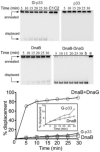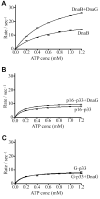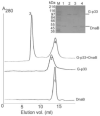Domain swapping reveals that the C- and N-terminal domains of DnaG and DnaB, respectively, are functional homologues
- PMID: 17367384
- PMCID: PMC3035176
- DOI: 10.1111/j.1365-2958.2007.05617.x
Domain swapping reveals that the C- and N-terminal domains of DnaG and DnaB, respectively, are functional homologues
Abstract
The bacterial primase (DnaG)-helicase (DnaB) interaction is mediated by the C-terminal domain of DnaG (p16) and a linker that joins the N- and C-terminal domains (p17 and p33 respectively) of DnaB. The crystal and nuclear magnetic resonance structures of p16 from Escherichia coli and Bacillus stearothermophilus DnaG proteins revealed a unique structural homology with p17, despite the lack of amino acid sequence similarity. The functional significance of this is not clear. Here, we have employed a 'domain swapping' approach to replace p17 with its structural homologue p16 to create chimeras. p33 alone hydrolyses ATP but exhibits no helicase activity. Fusing p16 (p16-p33) or DnaG (G-p33) to the N-terminus of p33 produced chimeras with partially restored helicase activities. Neither chimera interacted with DnaG. The p16-p33 chimera formed hexamers while G-p33 assembled into tetramers. Furthermore, G-p33 and DnaB formed mixed oligomers with ATPase activity better than that of the DnaB/DnaG complex and helicase activity better than the sum of the individual DnaB and G-p33 activities but worse than that of the DnaB/DnaG complex. Our combined data provide direct evidence that p16 and p17 are not only structural but also functional homologues, albeit their amino acid composition differences are likely to influence their precise roles.
Figures









Similar articles
-
Structure of hexameric DnaB helicase and its complex with a domain of DnaG primase.Science. 2007 Oct 19;318(5849):459-63. doi: 10.1126/science.1147353. Science. 2007. PMID: 17947583
-
Monomeric solution structure of the helicase-binding domain of Escherichia coli DnaG primase.FEBS J. 2006 Nov;273(21):4997-5009. doi: 10.1111/j.1742-4658.2006.05495.x. Epub 2006 Sep 28. FEBS J. 2006. PMID: 17010164
-
Mapping protein-protein interactions within a stable complex of DNA primase and DnaB helicase from Bacillus stearothermophilus.Biochemistry. 2000 Jan 11;39(1):171-82. doi: 10.1021/bi9918801. Biochemistry. 2000. PMID: 10625492 Free PMC article.
-
The bacterial helicase-primase interaction: a common structural/functional module.Structure. 2005 Jun;13(6):839-44. doi: 10.1016/j.str.2005.04.006. Structure. 2005. PMID: 15939015 Free PMC article. Review.
-
Regulation of bacterial priming and daughter strand synthesis through helicase-primase interactions.Nucleic Acids Res. 2006;34(15):4082-8. doi: 10.1093/nar/gkl363. Epub 2006 Aug 25. Nucleic Acids Res. 2006. PMID: 16935873 Free PMC article. Review.
Cited by
-
Inferring primase-DNA specific recognition using a data driven approach.Nucleic Acids Res. 2021 Nov 18;49(20):11447-11458. doi: 10.1093/nar/gkab956. Nucleic Acids Res. 2021. PMID: 34718733 Free PMC article.
-
An in trans interaction at the interface of the helicase and primase domains of the hexameric gene 4 protein of bacteriophage T7 modulates their activities.J Biol Chem. 2009 Aug 28;284(35):23842-51. doi: 10.1074/jbc.M109.026104. Epub 2009 Jul 1. J Biol Chem. 2009. PMID: 19574219 Free PMC article.
-
Structural Insight into the Specific DNA Template Binding to DnaG primase in Bacteria.Sci Rep. 2017 Apr 6;7(1):659. doi: 10.1038/s41598-017-00767-8. Sci Rep. 2017. PMID: 28386108 Free PMC article.
-
Primase is required for helicase activity and helicase alters the specificity of primase in the enteropathogen Clostridium difficile.Open Biol. 2016 Dec;6(12):160272. doi: 10.1098/rsob.160272. Open Biol. 2016. PMID: 28003473 Free PMC article.
-
Conserved residues of the C-terminal p16 domain of primase are involved in modulating the activity of the bacterial primosome.Mol Microbiol. 2008 Apr;68(2):360-71. doi: 10.1111/j.1365-2958.2008.06155.x. Mol Microbiol. 2008. PMID: 18366438 Free PMC article.
References
-
- Bhattacharyya S, Griep MA. DnaB helicase affects the initiation specificity of E. coli primase on single-stranded DNA templates. Biochem. 2000;39:745–752. - PubMed
-
- Bird LE, Wigley DB. The B. stearothermophilus replicative helicase: cloning, overexpression and activity. Biochim Bioph Acta. 1999;1444:424–428. - PubMed
-
- Biswas SB, Chen PH, Biswas EE. Structure and function of E. coli DnaB protein: role of the N-terminal domain in helicase activity. Biochem. 1994;33:11307–11314. - PubMed
Publication types
MeSH terms
Substances
Grants and funding
LinkOut - more resources
Full Text Sources

